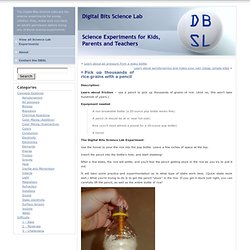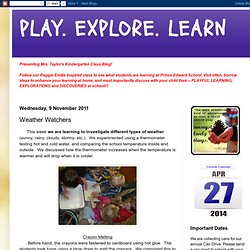

Amazon. Amazon. Amazon. Bismuth Crystal: Industrial & Scientific. Amazon. Gallium 99.99% Pure 20 Grams 4n Even Melt in Your Hand: Amazon.com: Industrial & Scientific. 10 Crazy Science Stunts You Can Do at Home #4. Science Projects for Kids: Chemical Reactions" With these science projects for kids: chemical reactions, your children can learn that, simply put, chemical reactions happen when one substance is turned into another.

Whether the color changes, the shape, the flexibility, or even an explosion occurs, these are all types of chemical reactions. The best part is that there's a project here for everyone. If your kids are interested in creating a bubbly mess, there's a project here for that. If your children enjoy leaving others in wonderment as to how they bent chicken bones, you can find it here. Or if they simply enjoy watching colors change before their eyes, they can do that, too. Keep reading to learn how to make science projects for kids: chemical reactions. Foam Cup Meltdown Help your kids melt a foam witch into a jar of acetate and sculpt be-witching masterpieces with the sticky goo. Chemical Poppers Your children can find out what happens when baking soda and vinegar are placed in a plastic film container. Acid Test Pee Pals. Kids Safe Chemical Reactions Experiments Menu. 7 Mind-Blowing Chemical Reactions You Won't Believe Are Real.
#3.

Reigniting a Candle Via Its Smoke Trail Maryna Maschewsky/iStock/Getty Images Here's a trick you can try at home without the risk of exploding your living room (well, without any more risk than usual; we don't know what your living situation is, Methew McConaughey). Light a candle. Blow it out. BrusspupAnd you now possess more entertainment value than a $150 million movie. It turns out that fire just loves itself some candle wax, which you probably knew, because, well ... candles.
. #2. Leigh Prather/iStock/Getty Images This is a chemical called europium tetrakis, demonstrating the effect of triboluminescence. NurdRageIf you look reeeeeal close, you can see a miniature Christopher Lambert in there. The effect happens when crystals don't bother to generate electricity or heat, but rather skip a step like the lazy crystal bastards they are and convert kinetic energy directly into light. RadiolabMunichThis is what Daft Punk sees every time they close their eyes. #1.
32 Mesmerising GIFs That Will Make You Fall In Love With Science. The 27 Most Impressive Chemical Reactions. Fun Science Experiments for Kids - Cool Projects & Easy Ideas for Children. Pre k science projects on Pinterest. Pin by Rebecca Stafos-Weaver on pre k science projects. Absorbing Science. Pick up thousands of rice grains with a pencil. Pick up thousands of rice grains with a pencil Description: Learn about friction – use a pencil to pick up thousands of grains of rice.

(And no, this won’t take hundreds of years.) Equipment needed: A non-breakable bottle (a 20-ounce pop bottle works fine)A pencil (it should be at or near full-size)Rice (you’ll need almost a pound for a 20-ounce pop bottle)A funnel The Digital Bits Science Lab Experiment: Use the funnel to pour the rice into the pop bottle. Insert the pencil into the bottle’s hole, and start stabbing! After a few stabs, the rice will settle, and you’ll feel the pencil getting stuck in the rice as you try to pull it out.
It will take some practice and experimentation as to what type of stabs work best. This experiment teaches about friction. When you stab the pencil into the rice and it “sticks”, the rice is packed against other grains of rice, with are all contained by the bottle. Other articles related to this topic: Pin by Rebecca Stafos-Weaver on pre k science projects. Weather Watchers. This week we are learning to investigate different types of weather (sunny, rainy, cloudy, stormy, etc.).

We experimented using a thermometer testing hot and cold water, and comparing the school temperature inside and outside. We discussed how the thermometer increases when the temperature is warmer and will drop when it is colder. Crayon Melting Before hand, the crayons were fastened to cardboard using hot glue. The students took turns using a blow dryer to melt the crayons. Other discussions that the students were engaged in were how the colours of the crayons mixed together, the shapes and splatter marks of the crayons as they melted, and how crayons not in wrappers melted quicker.
Pin by Rebecca Stafos-Weaver on pre k science projects. Familylicious Reviews and Giveaways. This is a variation to the borax/ glue slime that everyone makes I wanted it to fall through the baskets slowly and keep the runny consistency even after cooling so this is the recipe I came up with.

Ingredients: 1. 1/2 tsp borax2. 1 1/3 cups hot water In a separate bowl 1. 2 cups school glue2. 1 1/2 cups hot water3. liquid water color or food coloring Directions: 1. Use hanging strawberry baskets with buckets underneath to catch the mess.